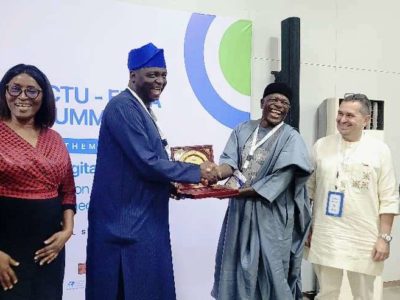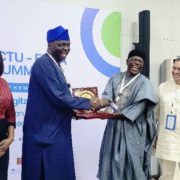Africa’s STI landscape is hampered by absence of political willpower and funding.
By SEGUN ORUAME
At about this time last year in Nairobi, Kenya, more than 30 African ministers of education and science attending the “First African Forum on Science, Technology and Innovation (STI) for Youth Employment, Human Capital Development and Inclusive Growth, unanimously pledged to put STI policies, strategies, programmes and plans into action over the next five years.”
More than 700 participants were at that event that focused on “the integration of STI policies into national and regional development agendas as well as STI financing mechanisms and investments.” STI has remained one of the most ignored but strategic areas among African governments. The contribution of South Africa’s scientific research output, which is about the best on the continent, to total global STI output is less than 0.5%. Though home to the continent’s largest population (about 170 million of Africa’s 800 million) and despite its huge earnings from crude oil export, Nigeria’s global STI output as at 2007 stood at an insignificant 0.0004. Africa is the least contributor to world’s STI output as the Knowledge Economy table below shows.
Lacking the political willpower and having poor appreciation of the STI as a game changer for full economic transformation, African governments have consistently paid lip service to STI thus most research centres are either not funded or poorly funded or completely ignored in national budgetary allocations. Nigeria is a classic example of how most African governments treat STI.
“The country’s R&D allocation is US$ 0.582 Billion (PPP) in 2007 which is approximately 0.0004% of the World’s expenditure on R&D as at 2011. This figure represents 0.2% of R&D expenditure as percentage of the national GDP (AIO, 2010). The country was ranked 127th out of 139 countries assessed in the 2011 Global Competitiveness Report” as one report indicates.
The financial condition of one of the country’s research centres in Zaria, northern Nigeria epitomizes the absence of official support for STI. In 2012, the total budgetary allocation for the National Research Institute for Chemical Technology (NARICT) was a meager N250 million. Even then, it only was able to accessed N50 million for the entire year. Despite its mandate as a research centre to proffer STI solutions that would advance the national economy, NARICT has been emasculated by both absence of fund and lack of willpower by the central government. When Baobab Africa People & Economy magazine spoke with Prof. Idris M. Bugaje, the director general of NARICT, he expressed similar concerns of administrators of STI centres on the continent. Governments do not give the necessary commitments to research on STI.
“If governments think they are serious on science and technology; both the executive and the legislature let them give funding to science and technology. When you give less than 0.01% of your budget to science and technology, how can there be any transformation? Transformation is an engineering word. If I give you the meaning of transformation in thermodynamics then you will realise Nigeria is nowhere. You can transform from one level to another but it requires certain quantum of energy. Quantum of input of science and technology and all those things are missing in this country. The budget is not implemented. Ours was so little. You wouldn’t believe our budget as a research institute last year and it was so poorly implemented that we got only 40% of N250 million for all our projects. How can anybody take government seriously on science and technology? Government has to invest more. The little money for the whole ministry was just about N36 billion last year,” lamented Prof Bugaje.
But the STI pulse is slowing picking up across the continent to go by the optimism of one report by the UN. The report says: Africa is making strides in technological and scientific development and innovation. “But indicators are crucial to formulate policies…. NEPAD is to develop a pan-African Science, Technology and Innovation Indicator (STII) and an African Science, Technology and Innovation Observatory that will prepare an African Innovation Outlook.” This observation by the UN was made over two years ago. There is a dire need to commit more funds and willpower to STI by governments.
Desirous of addressing the funding challenge for STI, the Nigerian government last year created the National Science Research Technology and Innovation Fund (NSRTIF). The NSRTIF is the fallout of the National Science Technology and Innovation Policy earlier approved for the country by the government as a way of addressing the shallow funding for STI. The policy is fostered on a similar policy for the IT sector which eventually laid the foundation for the creation of the National IT fund fed by law by 1% of after profit contributions of all operating IT companies in the country. If eventually backed by an Act, the NSRTIF would source funding for STI in much similar way as the National IT fund.
At the continental level, under the auspices of the AU, things appeared more clear-focused. A NEPAD initiative is already in existence to promote technical change and innovation by building skills in local software R&D. The project is being implemented through the African Virtual Open Initiatives and Resources (AVOIR) programme that currently works in Kenya, Mozambique, Senegal, South Africa, Tanzania and Uganda. Also, to support and promote access to scientific knowledge for African scientists, decision makers, students and researchers, UNECA has launched the “Access to Scientific Knowledge in Africa (ASKIA)” initiative seeking to provide ways for African scientists to tap into global scientific knowledge and develop indigenous knowledge that supports economic and industrial growth.
These are frameworks designed to improve the human capital element and education that are at the centre of a knowledge economy. International and regional organisations appear to be at the forefront of providing the crucial framework and even fund necessary to provide the education and skills that will determine ‘future social cohesion, economic prosperity and sustainability’ within the continent. Governments must key into this framework to successfully activate the momentum required to change the continent’s STI landscape for good.
“When you give less than 0.01% of your budget to science and technology, how can there be any transformation?”

















